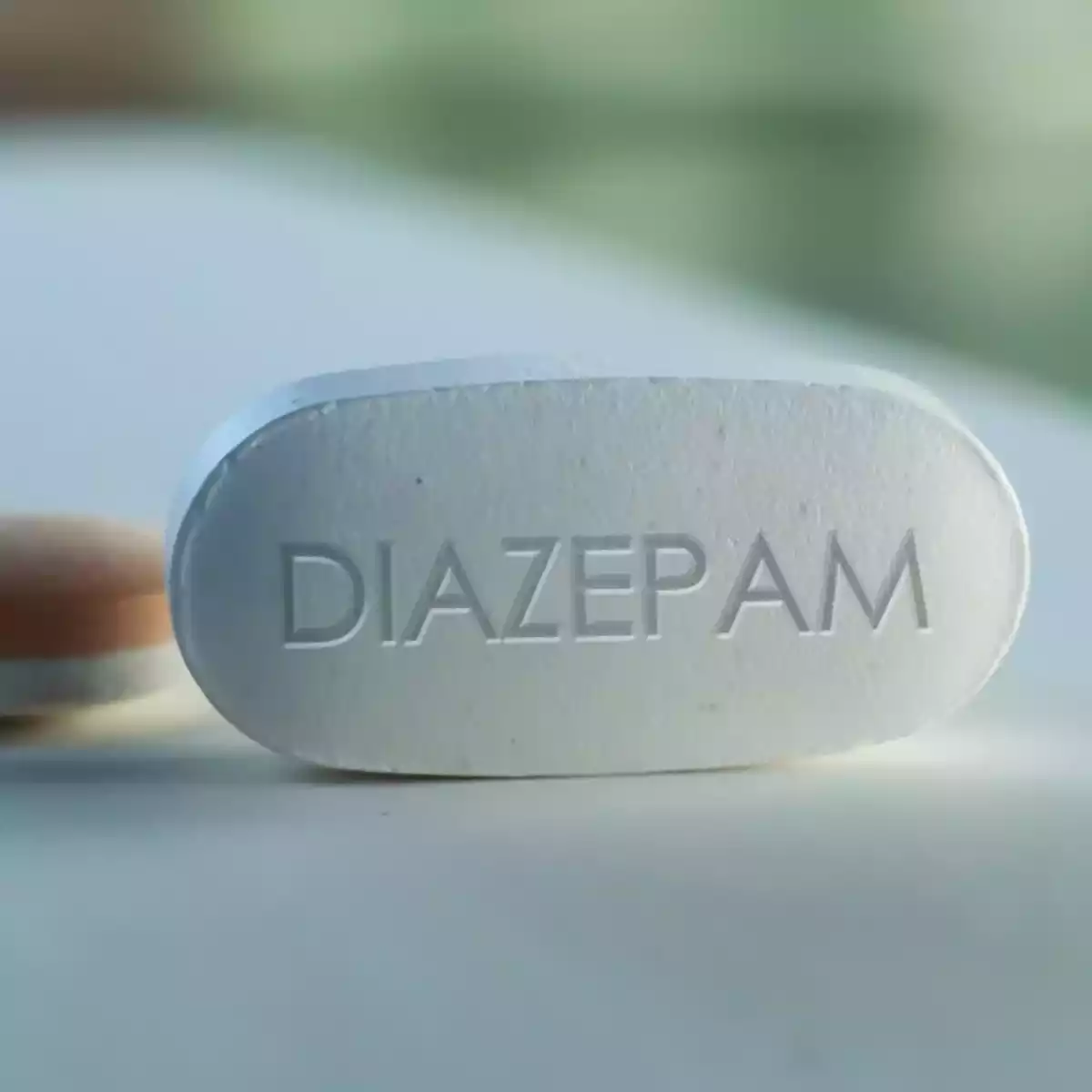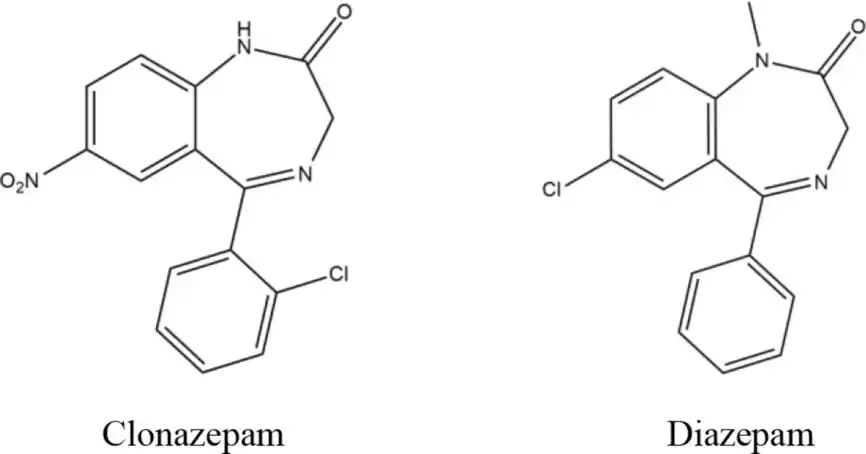Clonazepam and Diazepam are two commonly prescribed medications with distinct properties and applications. Understanding the differences between these drugs is crucial for both medical professionals and patients. This overview highlights key contrasts in terms of their mechanisms of action, medical uses, dosages, onset and duration of effects, potential side effects, interactions, and considerations for withdrawal and dependence.
What is Clonazepam?

Clonazepam is a pharmaceutical compound classified as a benzodiazepine. It acts as a central nervous system (CNS) depressant and is commonly prescribed for its anxiolytic (anti-anxiety), anticonvulsant (anti-seizure), and muscle relaxant properties. Clonazepam interacts with gamma-aminobutyric acid (GABA) receptors in the brain, enhancing the inhibitory effects of GABA neurotransmitters, which results in a calming and sedative effect.
This medication is primarily used to manage various conditions, including epilepsy and seizure disorders. Additionally, it is prescribed for panic disorder, generalized anxiety disorder, and social anxiety disorder. Clonazepam comes in various forms, such as tablets and orally disintegrating tablets, and its dosage and administration instructions are tailored to the specific condition being treated.
Due to its potential to cause dependence and withdrawal symptoms, Clonazepam is usually prescribed for short-term use or in cases where other treatments have been ineffective. It’s essential to follow medical guidance closely when using Clonazepam and to be aware of possible side effects and interactions with other substances or medications.
How Does Clonazepam Work?
Here’s a concise explanation of how Clonazepam works:
- Clonazepam is a benzodiazepine medication.
- It interacts with GABA (gamma-aminobutyric acid) neurotransmitter receptors in the brain.
- Clonazepam enhances the inhibitory effects of GABA.
- GABA is an inhibitory neurotransmitter that reduces neuronal activity.
- Clonazepam binding to GABA-A receptors opens chloride ion channels.
- Chloride ions entering neurons decrease their excitability.
- This leads to a calming and sedative effect on the central nervous system.
- Clonazepam’s action helps manage conditions like anxiety, panic disorders, and seizures.
- By reducing excessive neuronal firing, it promotes relaxation and tranquility.
Uses of Clonazepam
The uses of Clonazepam include:
- Seizure Disorders: Clonazepam is prescribed to manage various types of seizure disorders, including epilepsy. It helps control and reduce the frequency of seizures.
- Anxiety Disorders: Clonazepam is used to treat generalized anxiety disorder (GAD), panic disorder, and social anxiety disorder. It helps alleviate excessive anxiety and related symptoms.
- Panic Attacks: Clonazepam can be effective in reducing the frequency and severity of panic attacks, making it valuable for individuals with panic disorder.
- Agoraphobia: It’s sometimes prescribed alongside therapy to help manage agoraphobia, which is often linked with panic disorder.
- Restless Leg Syndrome (RLS): Clonazepam can provide relief from the discomfort and restlessness associated with RLS.
- Akathisia: It may be used to alleviate akathisia, a movement disorder characterized by restlessness.
- Bipolar Disorder: Clonazepam can be used as an adjunct treatment for managing certain aspects of bipolar disorder, such as anxiety or agitation.
- Insomnia: In some cases, Clonazepam may be prescribed for short-term use to help with insomnia, although its use for this purpose is less common.
It’s important to note that Clonazepam should be taken only under the guidance of a healthcare professional, as it carries the risk of dependence and should be used cautiously due to its potential for side effects and interactions with other substances or medications.
What is Diazepam?

Diazepam is a benzodiazepine medication that acts as a central nervous system depressant. It is commonly prescribed for its anxiolytic (anti-anxiety), muscle relaxant, and anticonvulsant (anti-seizure) properties. Like other benzodiazepines, Diazepam enhances the effects of gamma-aminobutyric acid (GABA) neurotransmitters in the brain, leading to a calming and sedative effect.
Diazepam has a range of medical uses. It is often prescribed to treat conditions such as anxiety disorders, muscle spasms, and alcohol withdrawal symptoms. Additionally, Diazepam is utilized as an adjunctive treatment for epilepsy and other seizure disorders. It can be administered in various forms, including tablets, oral solutions, and injectable formulations.
It’s important to note that Diazepam, like other benzodiazepines, carries a risk of dependence and withdrawal symptoms, particularly if used for extended periods. Due to these potential risks, Diazepam is generally prescribed for short-term use or in situations where other treatment options have not been effective. It’s crucial to follow medical advice closely when using Diazepam and to be aware of potential side effects and interactions with other substances or medications.
How Does Diazepam Work?
Diazepam can aid by increasing the effects of GABA neurotransmitter in your brain. Here’s how it works:
- GABA Receptor Interaction: Diazepam is a benzodiazepine medication. It binds to specific receptors known as GABA-A receptors in the brain.
- GABA Enhancement: GABA (gamma-aminobutyric acid) is an inhibitory neurotransmitter that reduces brain activity. When Diazepam binds to GABA-A receptors, it enhances the effects of GABA.
- Chloride Ion Channel Opening: Activation of GABA-A receptors by Diazepam results in the opening of chloride ion channels in neurons.
- Neuronal Inhibition: The entry of chloride ions hyperpolarizes neurons, making them less excitable. This leads to reduced neuronal firing and overall brain activity.
- Calming Effects: The reduction in neuronal activity leads to calming, sedative, and anxiolytic (anti-anxiety) effects. Diazepam helps alleviate anxiety, muscle spasms, and other symptoms.
- Therapeutic Benefits: By enhancing the effects of GABA, Diazepam is effective in treating conditions such as anxiety disorders, muscle spasms, seizures, and alcohol withdrawal.
- Short-Term Use: Due to its potential for dependence and withdrawal, Diazepam is typically prescribed for short-term use, especially when treating acute conditions like anxiety attacks or muscle spasms.
It’s important to note that Diazepam’s interaction with the GABA system leads to its anxiolytic, muscle relaxant, and sedative effects. An expert medical opinion should always be sought regarding any medications taken due to potential negative side effects and interactions.
Uses of Diazepam
Here are the common uses of Diazepam:
- Anxiety Disorders: Diazepam is prescribed to treat various anxiety disorders, including generalized anxiety disorder (GAD), panic disorder, and social anxiety disorder. It helps reduce excessive anxiety and promote relaxation.
- Muscle Spasms: Diazepam is used to relieve muscle spasms and muscle stiffness, often associated with conditions like muscle strains, injuries, or neurological disorders.
- Alcohol Withdrawal: It can help manage the symptoms of alcohol withdrawal syndrome, including anxiety, tremors, and seizures that can occur when an individual stops drinking alcohol.
- Seizure Disorders: Diazepam is effective in treating various seizure disorders, including epilepsy. It helps prevent or reduce the frequency and intensity of seizures.
- Sedation: Diazepam is used for preoperative sedation, procedural sedation, and sedation in critical care settings. Anxieties may be soothed through meditation.
- Insomnia (Short-Term Use): Diazepam may be used for short-term treatment of insomnia in some cases. This use is less common due to the risk of dependence and potential for addiction.
- Muscle Relaxation (Off-Label): In some cases, Diazepam is used off-label to promote muscle relaxation and alleviate conditions involving muscle tightness or spasm.
- Adjunct in Seizure Clusters: Diazepam can be administered rectally (as a gel) or intravenously to manage seizure clusters or acute repetitive seizures.
It’s important to use Diazepam only under the guidance of a healthcare professional, as it carries the risk of dependence, withdrawal, and side effects. The specific condition being treated will determine the appropriate dosage and duration of use.
Comparison Table of Clonazepam and Diazepam
Here’s a comparison table highlighting key aspects of Clonazepam and Diazepam:
| Aspect | Clonazepam | Diazepam |
|---|---|---|
| Class | Benzodiazepine | Benzodiazepine |
| Mechanism | Enhances GABA effects | Enhances GABA effects |
| Uses | Seizure disorders, anxiety, panic disorder, muscle disorders, RLS, agoraphobia | Anxiety, muscle spasms, alcohol withdrawal, seizures, sedation, insomnia (short-term) |
| Onset of Action | Rapid | Rapid to intermediate |
| Duration of Action | Intermediate to long | Intermediate to long |
| Dosage Forms | Tablets, orally disintegrating tablets | Tablets, oral solution, injectable |
| Potential for Dependence | High | High |
| Withdrawal Risk | Risk of withdrawal symptoms | Risk of withdrawal symptoms |
| Common Side Effects | Drowsiness, dizziness, memory issues, coordination problems, depression | Drowsiness, dizziness, muscle weakness, memory impairment, depression |
| Short-Term Use | Common for acute conditions | Common for acute conditions |
| Long-Term Use | Less common due to dependence risk | Less common due to dependence risk |
| Considerations | Short-term or when other treatments are ineffective | Short-term or when other treatments are ineffective |
| Precautions | Caution with alcohol, potential interactions with other medications | Caution with alcohol, potential interactions with other medications |
| Medical Supervision | Close monitoring and guidance by healthcare professional | Close monitoring and guidance by healthcare professional |
This table provides a general overview and should not replace the guidance of a healthcare professional. The choice between Clonazepam and Diazepam depends on the specific condition being treated, individual patient factors, and the assessment of a medical provider. Always consult a healthcare professional before making any decisions regarding medication use.
What are the similarities between Clonazepam and Diazepam?

Here are the similarities between Clonazepam and Diazepam:
- Benzodiazepine Class: Both Clonazepam and Diazepam belong to the benzodiazepine class of medications.
- Mechanism of Action: Both drugs work by enhancing the effects of the neurotransmitter GABA (gamma-aminobutyric acid) in the brain, leading to calming and sedative effects.
- Anxiety Treatment: Both medications are used to treat various anxiety disorders, including generalized anxiety disorder, panic disorder, and social anxiety disorder.
- Seizure Management: Both Clonazepam and Diazepam are effective in managing seizure disorders, such as epilepsy.
- Dependence Risk: Both medications have the potential to cause physical dependence with long-term use, leading to withdrawal symptoms upon discontinuation.
- Side Effects: Both drugs can cause similar side effects, including drowsiness, dizziness, memory impairment, and coordination problems.
- Short-Term Use: Both Clonazepam and Diazepam are commonly prescribed for short-term treatment of acute conditions, such as anxiety attacks or muscle spasms.
- Medical Supervision: Both medications require close medical supervision and should be used under the guidance of a healthcare professional.
While these medications share similarities, it’s important to remember that they also have differences, including variations in potency, duration of action, and specific medical uses. The decision to use Clonazepam or Diazepam should be made in consultation with a healthcare provider based on the individual’s condition and medical history.
Common side effects of Clonazepam and Diazepam
Here are the common side effects that both Clonazepam and Diazepam can cause:
Common Side Effects:
- Drowsiness: Both medications can lead to drowsiness or excessive sleepiness, affecting cognitive and motor skills.
- Dizziness: Feeling dizzy or lightheaded is a frequent side effect.
- Memory Issues: Some individuals may experience memory problems or difficulty concentrating.
- Coordination Problems: Both medications can impair coordination and balance.
- Depression: In some cases, they may lead to mood changes, including feelings of depression.
- Digestive Issues: Nausea, vomiting, and gastrointestinal discomfort can occur.
- Tolerance and Dependence: There’s a risk of developing tolerance, physical dependence, and withdrawal symptoms with prolonged use.
It’s important to note that while these side effects are common, not everyone will experience them, and the severity can vary from person to person. It’s crucial to use Clonazepam and Diazepam under the guidance of a healthcare professional and to report any unusual or severe side effects promptly.
Summary
Clonazepam and Diazepam are benzodiazepine medications that enhance the effects of the neurotransmitter GABA in the brain, leading to calming and sedative effects. They are used to treat anxiety disorders and seizure disorders, but they carry a risk of dependence and should be used under medical supervision for short-term treatment.
While they have similarities, their specific uses, dosages, and potential side effects should be discussed with a healthcare professional to determine the most suitable option for an individual’s condition.



